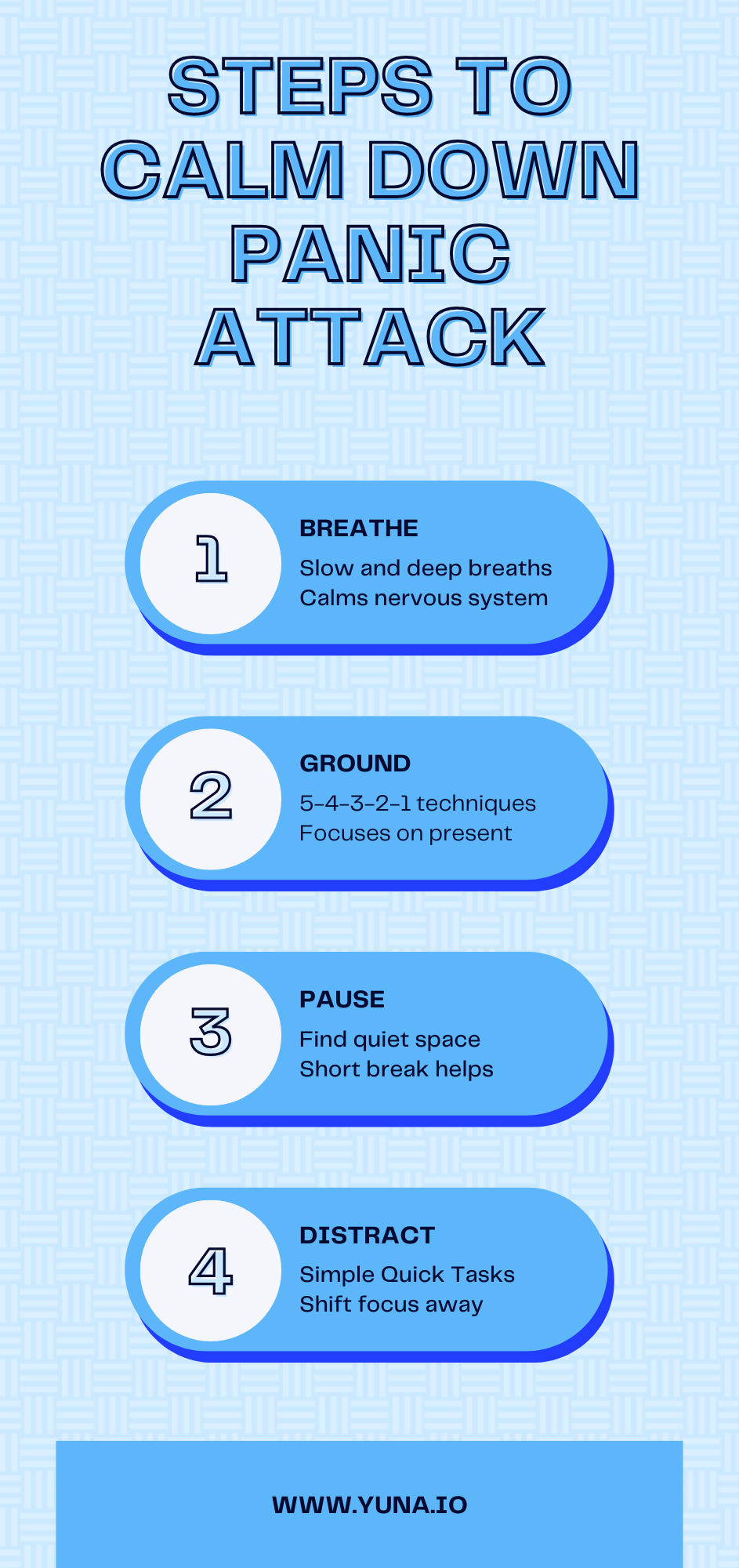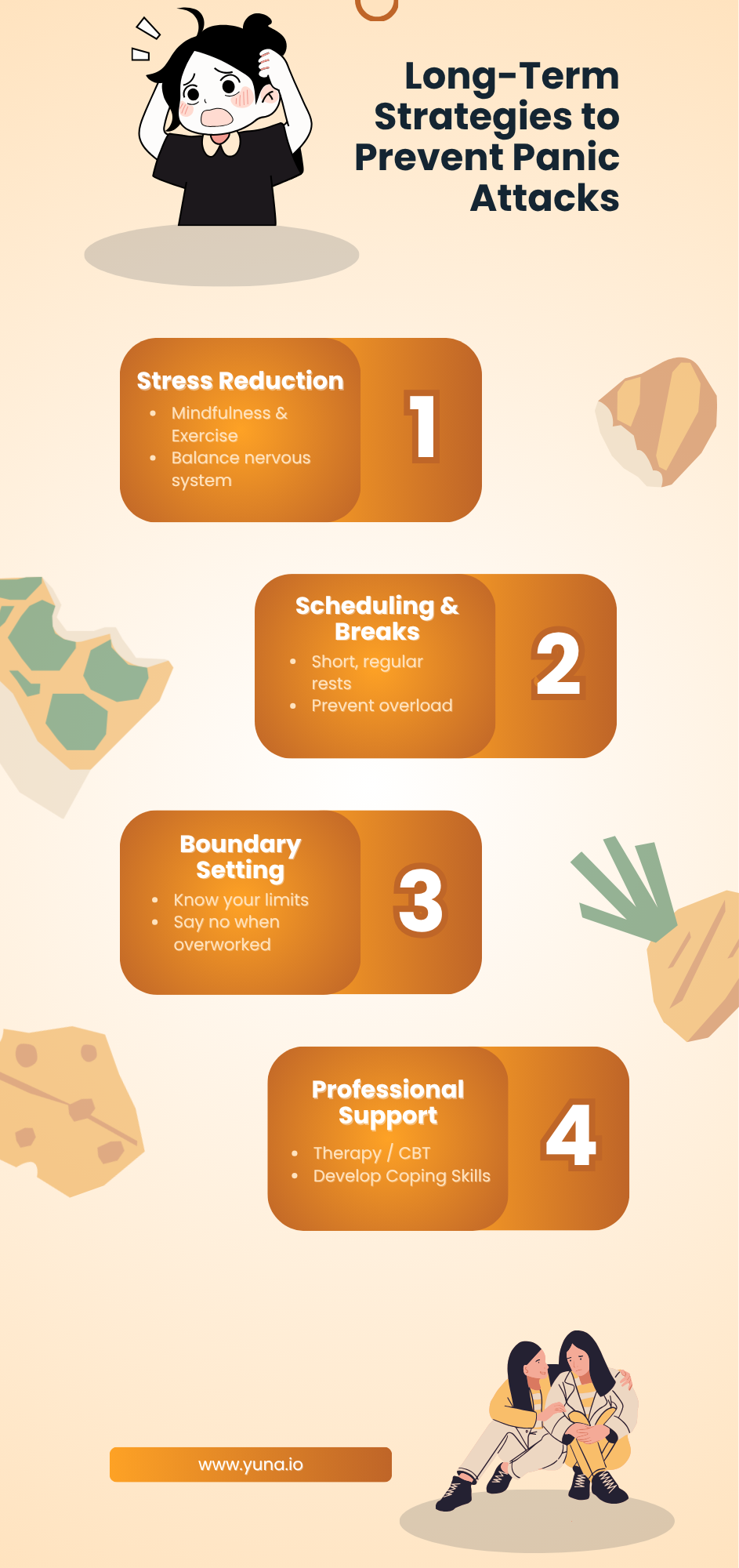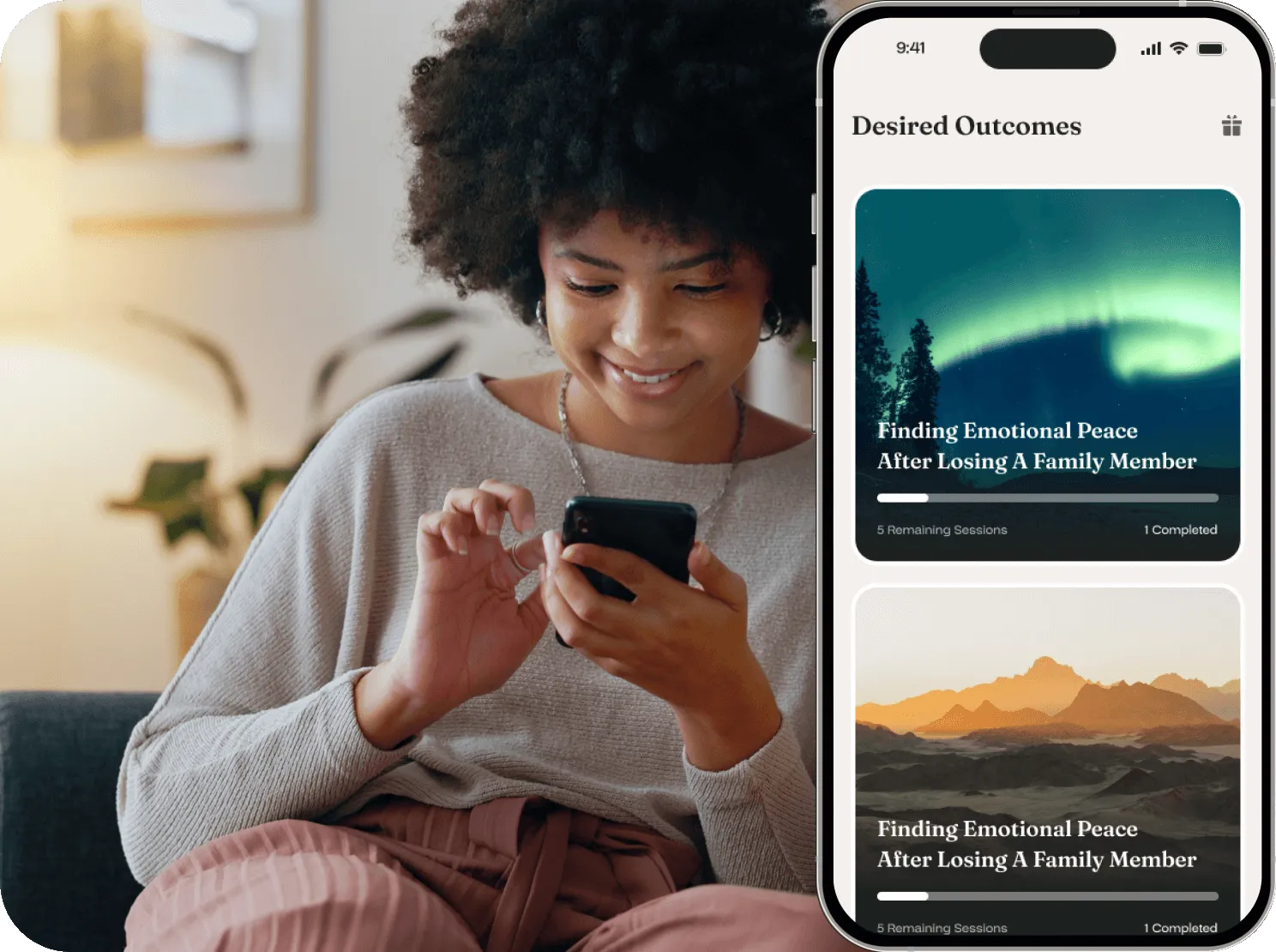A panic attack at work can feel overwhelming. It often strikes without warning, leaving employees confused, scared, or embarrassed. Unlike regular stress, a panic attack comes with intense physical and emotional reactions. The heart races, thoughts spin, and the sense of control slips away.
An anxiety attack at work not only affects the person experiencing it but can also interrupt focus, productivity, and confidence. Many people feel the need to hide what happened, which only adds more pressure. Recognizing what is happening and knowing how to respond can help employees manage the moment with more ease.
This article explains how to recognize a panic attack at work, the steps to calm down, how to recover after it passes, long-term strategies for prevention, the role of supportive workplace culture, and answers to common questions.
Recognizing a Panic Attack at Work
Awareness is the first step in managing panic. Panic attacks often feel like medical emergencies because of how sudden and intense the symptoms are. Understanding the difference between stress and panic helps employees and managers know when to act with care.
Physical Symptoms
Physical signs of a panic attack at work can be alarming. A racing heart, sweaty palms, trembling hands, chest tightness, and dizziness are all common. These symptoms mimic health emergencies like a heart attack, which increases fear and panic. Many employees first believe something is physically wrong before realizing it is a panic response. This confusion makes the experience even more stressful in a workplace setting.
Emotional Symptoms
Along with physical signs, emotional symptoms also show up. These can include a sense of dread, fear of losing control, or even feeling detached from the moment. The emotions can be overwhelming and may resemble what happens during anxiety attacks at work. A person may struggle to focus, feel consumed by fear, or believe something bad is about to happen.
Situational Triggers at Work
Workplaces come with many stressors that can trigger panic. Common triggers include presentations, strict deadlines, or conflicts with colleagues. Open office spaces can also cause sensory overload with constant noise and activity. In some cases, the emotional pressure spills over, leading to a crying panic attack at work. These triggers are different for each person, but they often follow similar patterns of pressure or overstimulation.

Immediate Steps to Calm Down A Panic Attack at Work
Once someone recognizes they are having a panic attack, the next step is to take immediate action. These quick methods help calm the body and mind in the moment.
Controlled Breathing
Breathing exercises are one of the simplest ways to respond to panic. Taking slow, deep breaths helps reset the body’s stress response. Inhale deeply through the nose, hold for a few seconds, and then exhale slowly through the mouth. This process slows the nervous system and signals safety to the brain. Controlled breathing brings the racing heart and trembling under control.
Grounding Techniques
Grounding techniques redirect attention away from overwhelming thoughts. One common method is the “5-4-3-2-1” approach: notice five things you see, four you feel, three you hear, two you smell, and one you taste. This practice shifts focus back to the present. It interrupts the spiral of panic and restores balance. You can also explore more ideas in our guide on journaling prompts for mental health.
Safe Space or Short Break
Sometimes the best option is stepping away. Finding a quiet restroom, an empty meeting room, or stepping outside for fresh air can help. A short break reduces sensory input and provides space to recover. Even a few minutes away from the stress triggers can help the body reset.
Distraction Methods
Simple distractions can also help the mind shift gears. Writing quick notes, sipping water, or stretching in place are all useful. These actions re-engage the brain in neutral tasks and move attention away from fear. Distractions can be small, but they play a big role in how to deal with a panic attack at work. Knowing how to handle panic attacks at work with these simple steps makes the moment more manageable.
Recovery & Return After the Attack
Calming down is only the first step. After a panic attack, employees need a plan to return to their tasks without shame or extra stress. Recovery is about giving yourself time and building confidence.
Gentle Return to Tasks
It helps to start small. Focus on easy, manageable tasks before moving back to demanding projects. This gentle return lowers the chance of feeling overwhelmed again. Employees should remind themselves that taking things slowly is not a weakness but a smart choice.
Debrief with Manager or Peer
Some employees may choose to share what happened with a trusted manager or colleague. This is not required, but it can reduce misunderstanding. A short debrief builds trust and helps others understand why you may need small adjustments. Managers who respond with empathy can create a safer work environment.
Tracking Patterns
Keeping track of when panic attacks happen helps in prevention. Writing down triggers, times, and feelings can reveal patterns. Journaling or using digital tools can make this easier. Many employees think back and say, “I had a panic attack at work,” but without tracking, they miss useful insights. Patterns can highlight stress points that need attention.

Long-Term Strategies to Prevent Attacks
Beyond single episodes, building habits and supportive systems helps reduce the risk of future panic. Small daily practices add up to stronger resilience.
Stress Reduction Techniques
Mindfulness, meditation, and exercise are effective tools to lower stress. Even a few minutes of meditation or stretching during the day can prevent tension from building. These habits help balance the nervous system and reduce the chance of panic attacks.
Scheduling & Breaks
Busy schedules often create the conditions for panic. Taking short breaks throughout the day prevents overload. Alternating between focused work and short rest supports steady energy. It is easier to sustain performance without reaching the point of burnout.
Boundary Setting
Employees need to know their limits. Saying no to extra work when already overloaded is an act of balance, not weakness. Clear communication about boundaries protects both mental health and productivity. It is an important step in preventing panic triggers.
Professional Support / Therapy
Sometimes professional help is the best option. Therapy, CBT, or employee assistance programs provide structured support. Professional guidance helps employees understand triggers and develop coping skills. Long-term support reduces the chance of repeated panic attacks at work or frequent anxiety attack at work episodes.
Changing Work Culture to Support Panic & Anxiety
While individual action matters, workplaces also shape how employees experience anxiety. A supportive culture reduces stigma and gives employees confidence to manage their mental health.
Mental Health Policies & Leave
Clear policies about mental health days signal that well-being is valued. Allowing flexibility for recovery normalizes the idea that mental health is as important as physical health. This policy-level support encourages employees to prioritize care without guilt.
Manager Awareness & Training
Leaders play a central role in shaping culture. Training managers to recognize signs of anxiety and panic prepares them to respond with understanding. Empathy instead of judgment builds a safe workplace. Employees feel less fear of being singled out when attacks happen.
Peer Support Networks
Colleagues can also provide comfort. Employee resource groups, safe spaces, or peer mentorship programs reduce stigma. Having a supportive network makes it easier to talk about anxiety attacks at work. It also builds trust across teams. When culture changes, knowing how to deal with a panic attack at work becomes a shared responsibility.

Let Yuna Support You Through Panic & Anxiety at Work
Panic attacks at work are tough, but employees do not have to manage them alone. Yuna Health provides tools and support that make a difference. With Yuna, employees can access calming exercises, reminders for mindful breaks, and resources for stress management. Leaders can also use Yuna to track inclusion, encourage feedback, and build better communication habits.
Yuna Health makes it easier to practice how to handle panic attacks at work by offering structured guidance. It also supports long-term resilience by keeping wellness part of the daily routine. Accessible both for individuals and organizations, Yuna brings mental health tools into everyday work life.
If your workplace is ready to build a supportive culture, Yuna Health can help. Partner with us to create teams that feel safe, valued, and equipped to handle challenges. Together we can make every employee stronger in the face of stress and panic attack at work experiences.
FAQs
What causes panic attacks at work?
Panic attacks at work can be caused by stress, deadlines, high workloads, or personal worries carried into the office. Sensory overload, fear of judgment, or past anxiety also act as triggers.
What should I say if I have an anxiety attack at work?
It depends on your comfort level. Some people choose to simply say they need a break or feel unwell. Sharing only what feels safe helps reduce pressure while you recover.
Can I still work after a panic attack at work?
Yes, many employees return to work after an episode. The key is to take time to reset before resuming tasks. Start small, then gradually take on normal responsibilities again.
What is a crying panic attack at work?
A crying panic attack at work is when panic triggers overwhelming emotions that lead to tears. It is a visible expression of stress, fear, and loss of control. It is common and not a sign of weakness.
How to handle panic attacks at work if they happen often?
If panic attacks are frequent, seek professional help. Therapy, stress management techniques, and workplace adjustments can make a difference. Consistent habits and open communication also reduce recurrence.


.webp)



